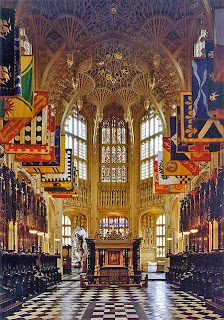My elation as I stumbled upon pictures of Chartres Cathedral was unprecedented. Not only did I take a picture of the westwork, but I actually went inside to take pictures of the stained glass. Though my textbook offers much better quality pictures, I cannot help but be sentimental and post my own pictures.
Chartres is actually the French Gothic cathedral that bothers me. The two differing towers on the west facade do not sit well with my OCD-ness. What makes Chartres unique is the mixture of Early and High French Gothic elements. The west facade still has several Romanesque qualities. The decoration of the "Royal Portal" has a theme similar to the Romanesque Throne of Wisdom. However, Mary was given an unprecedented positio
n of prominence on the Chartres portal. The jamb statues of the Royal Portal display the Early Gothic emergence of naturalism.
Like other churches of the time, Chartres could not fend off fires. In 1194, a disastrous fire destroyed the majority of the cathedral--only the western facade and masonry of the crypt remained. A rebuilding
effort started immediately and took a short
27 years. The new plan of Chartres is High Gothic. Rectangular bays replaced the old square bays, and four part vaults took the place of the Early Gothic sexpartite vaults. The result of the changes was a huge, continuous hall.
Lastly, the new sculptures on the south transept of Chartres show the transformation from Early to HighGothic in sculpture. The individuals that are depicted have distinct personalities are not as rigid as their Early Gothic predecessors. Signs of Classical influence are seen in the use of contrappos
to in some of the figures.
What memories do I have of Chartres? I remember taking a picture with my friends and looking at brochures. In the spirit of Thanksgiving, I am thankful that I no longer take a ridiculous amount of self-pics or pictures of my feet, and that at least I now appreciate the sights that I saw while in France, even if it took 4 years.
Proof.


